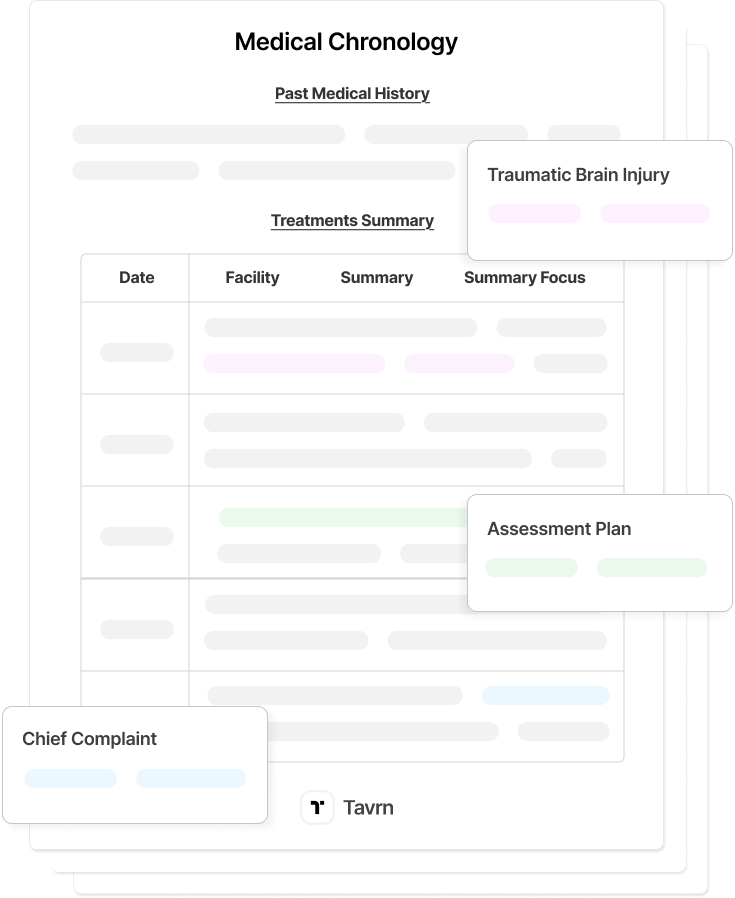Every week of delay in obtaining complete medical records extends case preparation timelines, postpones settlement negotiations, and constrains cash flow. AI can help, but most firm principals aren’t clear on how.
Traditional retrieval methods often require 30-90 days and force paralegals to spend hours personally chasing providers. AI-powered systems can complete the same work faster with minimal manual intervention.
This analysis examines how traditional and AI-powered retrieval methods differ across operational performance, accuracy, resource allocation, scalability, and compliance, demonstrating why automation has become a measurable advantage in personal injury practice.
Understanding Medical Record Retrieval Methods
Traditional and AI-driven medical record retrieval methods differ substantially in their operational characteristics. These differences become measurable when examining five key areas: processing speed, accuracy rates, cost efficiency, volume capacity, and compliance management.
Traditional Medical Record Retrieval
Traditional medical record retrieval follows a standardized nine-step manual workflow that consumes substantial staff time and introduces multiple delay points:
- Identify all medical providers involved in the claim and create a comprehensive provider list.
- Verify provider contact information and preferred record request procedures for each facility.
- Prepare and execute HIPAA authorizations for each provider, securing signatures from the client or claimant.
- Obtain additional authorizations for protected or sensitive categories.
- Draft formal record request letters including claimant demographics, dates of service, and case identifiers.
- Assemble supporting documentation such as billing records, consent forms, and certification statements.
- Submit requests individually to each provider’s Health Information Management (HIM) department.
- Track and follow up on all outstanding requests via phone, fax, or email to confirm processing and payment.
- Receive, review, and organize records, checking for completeness and requesting missing pages or corrections as needed.
Senior paralegals report dedicating a significant proportion of their time to administrative follow-up rather than substantive case analysis. Moreover, despite HIPAA’s 30-day retrieval window, many providers take longer to return a complete record set, creating cascading delays that further slow case preparation and settlements.
AI-Driven Medical Record Retrieval
AI-driven medical record retrieval automates every stage of the process, from validating authorizations to acquiring, reading, and organizing records. Instead of relying on manual follow-ups or data entry, these systems manage retrieval continuously and ensure that records arrive complete and ready for analysis.
Typical functions of AI retrieval platforms include:
- Verifying authorization forms and identifying missing or incorrect information before submission.
- Requesting and tracking records from multiple providers simultaneously.
- Reading and organizing documents automatically using text recognition and data extraction.
- Detecting duplicates and tagging critical details such as treatment dates, diagnoses, and provider names.
- Delivering records in structured, searchable formats for immediate case preparation.
Firms using these systems report faster record delivery, fewer manual errors, and measurable cost savings tied to reduced staff workload.
Comparative Analysis: Traditional vs. AI Methods
The differences between traditional and AI-driven medical record retrieval methods become most apparent when comparing their impacts on time, cost, and scalability.
1. Speed and Turnaround Time
Traditional retrievals operate on provider-dependent timelines that span a month per request. Paralegals need to maintain logs and make follow-up calls every few weeks, consuming hours a month without guaranteed results.
AI retrieval systems achieve up to 70% time reduction through automated reminders, parallel processing capabilities, and intelligent routing protocols. Independent research demonstrates processing improvements from traditional timelines to up to seven business days for comparable record sets.
This speed differential creates measurable business impact for contingency-fee firms. Faster retrieval enables earlier chronology development, accelerated demand letter preparation, and shorter settlement cycles that improve quarterly cash flow performance.
2. Accuracy, Completeness, and Quality Control
Manual processes depend entirely on paralegal diligence and provider cooperation, creating risks of missing pages, duplicate records, and incomplete documentation.
AI systems provide automated cross-referencing capabilities that detect missing records and eliminate duplicates through intelligent document comparison.
AI-based retrieval systems demonstrate accuracy rates consistently above manual review averages, delivering greater consistency while still requiring human oversight to ensure completeness and legal defensibility.
3. Cost and Resource Efficiency
Traditional methods incur hidden costs by allocating billable time to clerical functions rather than to legal analysis.
AI implementation involves initial costs offset by measurable productivity and staffing gains. Automation significantly reduces manual labor requirements, allowing firms to process more cases without proportional increases in payroll and to realize faster returns on technology spend.
4. Scalability and Volume Capacity
Traditional workflows scale linearly with staffing requirements. Each additional case requires proportional paralegal hours for record processing, creating operational constraints that force firms to decline viable cases due to capacity limitations.
AI systems scale horizontally through automated batch processing, handling hundreds of concurrent retrievals without additional staff. This capacity differential determines how many cases firms can efficiently accept and process, directly impacting revenue potential and market positioning.
Scalability represents the difference between sustainable growth and operational bottlenecks that constrain profitability.
5. Compliance, Privacy, and Security
Both traditional and AI methods must maintain HIPAA compliance and SOC 2 requirements, which are essential for legal practice. Traditional processes rely on manual controls, including secure fax transmission, locked filing systems, and staff training protocols.
AI systems embed compliance controls within system architecture through automated encryption, audit trails, access controls, and anomaly detection capabilities. These mechanisms help ensure data integrity, accountability, and adherence to evolving regulatory standards.
Professional responsibility compliance demands human oversight regardless of automation level, but AI systems provide enhanced audit capabilities and systematic compliance controls that reduce the need for administrative oversight.
Results of AI Medical Record Retrieval in Law Firms
Verified implementations show measurable operational and financial gains for firms adopting AI medical record retrieval systems:
- Up to 70% reduction in medical record review time, with retrievals completed in days instead of weeks.
- Staff reallocation from document handling to strategy and case analysis, improving overall productivity.
- Improved quarterly liquidity and case capacity, as faster case progression enables firms to accept more matters without increasing overhead.
These results demonstrate how automation directly strengthens case readiness, efficiency, and profitability in contingency-fee practices.
Choosing Between Traditional and AI Medical Record Retrieval Methods
Traditional medical record retrieval remains familiar and dependable, particularly for firms with established provider relationships or smaller active caseloads. However, even at lower volumes, manual workflows extend timelines and divert paralegal hours toward administrative tasks rather than case strategy.
AI-driven retrieval offers measurable advantages regardless of firm size. Automation improves record turnaround times, eliminates repetitive follow-up, and keeps files organized and searchable for faster case preparation. Industry analysis from the Association of Legal Administrators show that firms adopting AI-driven retrieval reduce document preparation time by up to 50%, achieving faster settlements and clearer ROI as case volume grows.
For smaller practices, automation delivers earlier recoveries and stronger staff utilization; for larger firms, it scales seamlessly without proportional increases in overhead.
How to Implement AI in Record Retrieval
Transitioning from manual to AI-driven retrieval follows a structured adoption process. Successful implementations share common characteristics: measured rollouts, baseline performance metrics, staff training protocols, and defined success criteria.
1. Challenges and Readiness
Adopting AI record retrieval requires a phased rollout rather than immediate replacement. Most firms begin with pilot programs and parallel manual processes to validate performance. Confirming vendor reliability, system uptime, and compliance certifications minimizes risk during early implementation.
2. Initial Assessment
Turnaround times, staff hours, and per-case costs benchmark current retrieval performance. Firms use these baselines to quantify ROI and efficiency gains after introducing automation. Pilot testing should begin with representative case types to evaluate performance without affecting critical client matters.
3. Training Requirements
Effective implementation depends on staff confidence and a clear understanding of new workflows. Firms that succeed with AI record retrieval typically provide structured onboarding that demonstrates how automation reduces repetitive work, freeing up more time for substantive case analysis. This approach helps position AI as a professional enhancement rather than a replacement for expertise.
4. Measuring Implementation Success
Firms that track retrieval time reduction, error rate improvement, and staff efficiency typically see clear evidence of automation’s impact. Reported ROI often reflects both lower administrative costs and added revenue capacity from handling more cases without increasing headcount. Once accuracy, compliance, and user adoption stabilize, automation naturally scales to a broader share of workflows.
Moving Forward with AI Record Retrieval
AI-driven medical record retrieval transforms what was once a weeks-long administrative process into a streamlined workflow that drives measurable results. For legal teams handling personal injury, medical malpractice, or disability claims, automation delivers faster case readiness and stronger financial performance.
Tavrn retrieves complete medical records in days, not weeks, and cuts review time by up to 70%. Firms using Tavrn process more cases without adding staff, gain transparency across retrieval workflows, and free paralegals to focus on strategy and client advocacy instead of document management.
See how Tavrn transforms medical record retrieval — book a demo.











